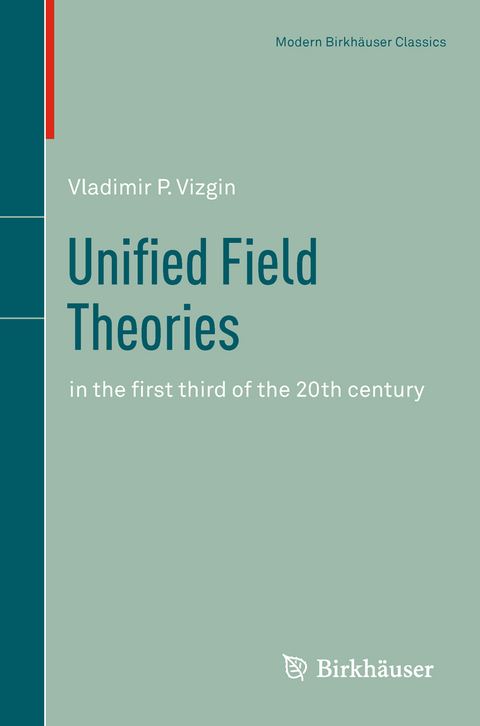
Unified Field Theories
in the first third of the 20th century
Seiten
2011
Springer Basel (Verlag)
9783034801737 (ISBN)
Springer Basel (Verlag)
9783034801737 (ISBN)
Drawing on Russian sources, the author analyses the early further development of unified field theories. He presents the evolution of these theories as a process of interaction and competition between geometric field and quantum research programs.
Despite the rapidly expanding ambit of physical research and the continual appearance of new branches of physics, the main thrust in its development was and is the attempt at a theoretical synthesis of the entire body of physical knowledge. The main triumphs in physical science were, as a rule, associ ated with the various phases of this synthesis. The most radical expression of this tendency is the program of construction of a unified physical theory. After Maxwellian electrodynamics had unified the phenomena of electricity, magnetism, and optics in a single theoretical scheme on the basis of the con cept of the electromagnetic field, the hope arose that the field concept would become the precise foundation of a new unified theory of the physical world. The limitations of an electromagnetic-field conception of physics, however, already had become clear in the first decade of the 20th century. The concept of a classical field was developed significantly in the general theory of relativity, which arose in the elaboration of a relativistic theory of gravitation. It was found that the gravitational field possesses, in addition to the properties inherent in the electromagnetic field, the important feature that it expresses the metric structure of the space-time continuum. This resulted in the following generalization of the program of a field synthesis of physics: The unified field representing gravitation and electromagnetism must also describe the geometry of space-time.
Despite the rapidly expanding ambit of physical research and the continual appearance of new branches of physics, the main thrust in its development was and is the attempt at a theoretical synthesis of the entire body of physical knowledge. The main triumphs in physical science were, as a rule, associ ated with the various phases of this synthesis. The most radical expression of this tendency is the program of construction of a unified physical theory. After Maxwellian electrodynamics had unified the phenomena of electricity, magnetism, and optics in a single theoretical scheme on the basis of the con cept of the electromagnetic field, the hope arose that the field concept would become the precise foundation of a new unified theory of the physical world. The limitations of an electromagnetic-field conception of physics, however, already had become clear in the first decade of the 20th century. The concept of a classical field was developed significantly in the general theory of relativity, which arose in the elaboration of a relativistic theory of gravitation. It was found that the gravitational field possesses, in addition to the properties inherent in the electromagnetic field, the important feature that it expresses the metric structure of the space-time continuum. This resulted in the following generalization of the program of a field synthesis of physics: The unified field representing gravitation and electromagnetism must also describe the geometry of space-time.
Vladimir Pavlovich Vizgin is a Professor at S.I. Vavilov Institute for the History of Science and Technology of the Russian Academy of Science (Moscow).
1 The Electromagnetic Program for the Synthesis of Physics.- 2 The General Theory of Relativity: The Core of the Program of Unified Field Theories.- 3 Weyl's Theory: The First Truly Geometrized Unified Field Theory.- 4 1921: The Pivotal Year of Unified Geometrized Field Theories.- 5 Einstein's Decade of Hopes and Disappointments.- 6 The Role of Unified Geometrized Field Theories in the Genesis and Development of Quantum Theory.- Concluding Remarks.
| Erscheint lt. Verlag | 26.6.2011 |
|---|---|
| Reihe/Serie | Science Networks. Historical Studies |
| Übersetzer | J.B. Barbour |
| Zusatzinfo | XIX, 336 p. |
| Verlagsort | Basel |
| Sprache | englisch |
| Gewicht | 540 g |
| Themenwelt | Mathematik / Informatik ► Mathematik ► Allgemeines / Lexika |
| Schlagworte | Feldtheorie (Mathematik) |
| ISBN-13 | 9783034801737 / 9783034801737 |
| Zustand | Neuware |
| Informationen gemäß Produktsicherheitsverordnung (GPSR) | |
| Haben Sie eine Frage zum Produkt? |
Mehr entdecken
aus dem Bereich
aus dem Bereich
ein Übungsbuch für Fachhochschulen
Buch | Hardcover (2023)
Carl Hanser (Verlag)
CHF 23,75


